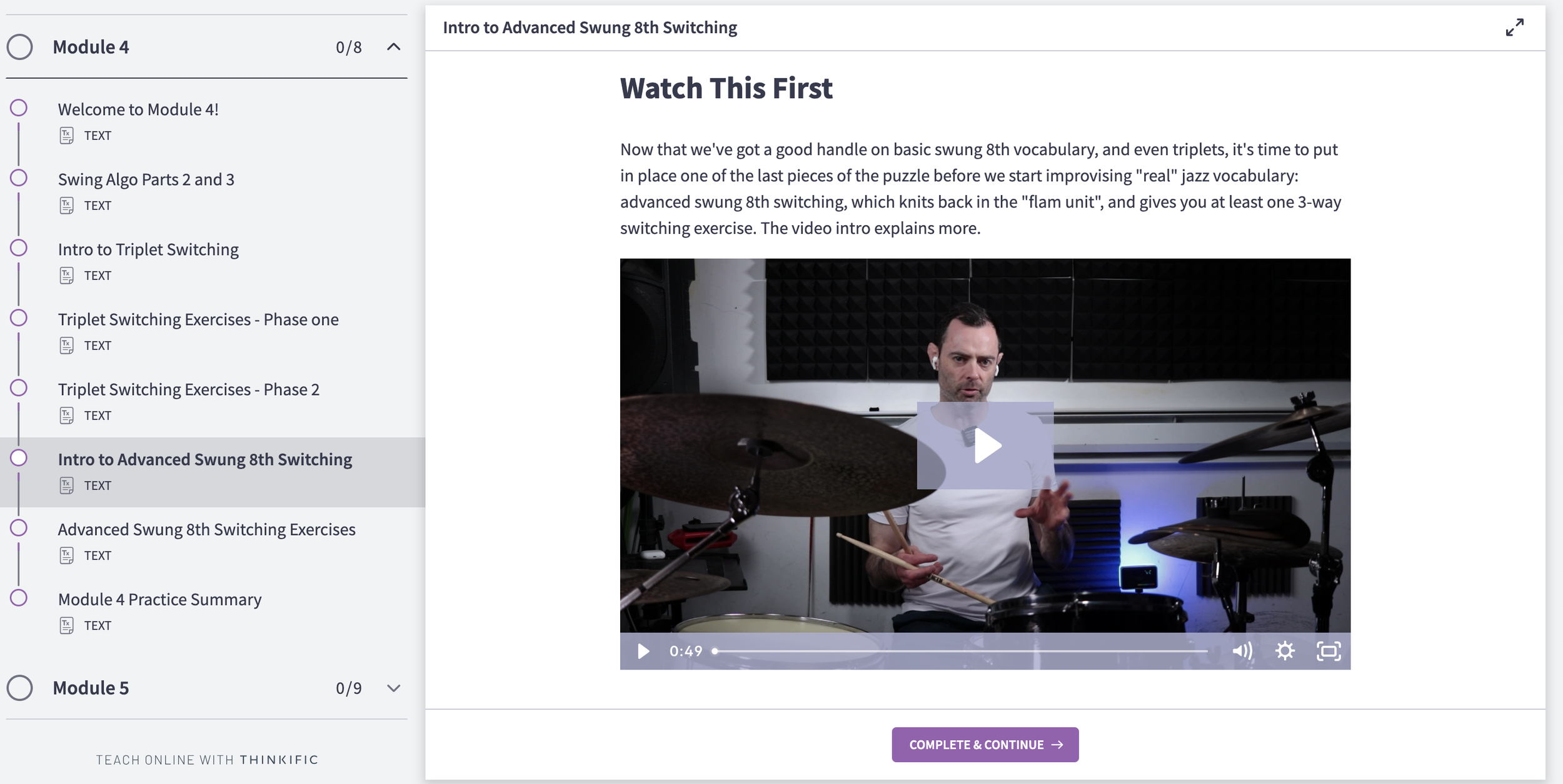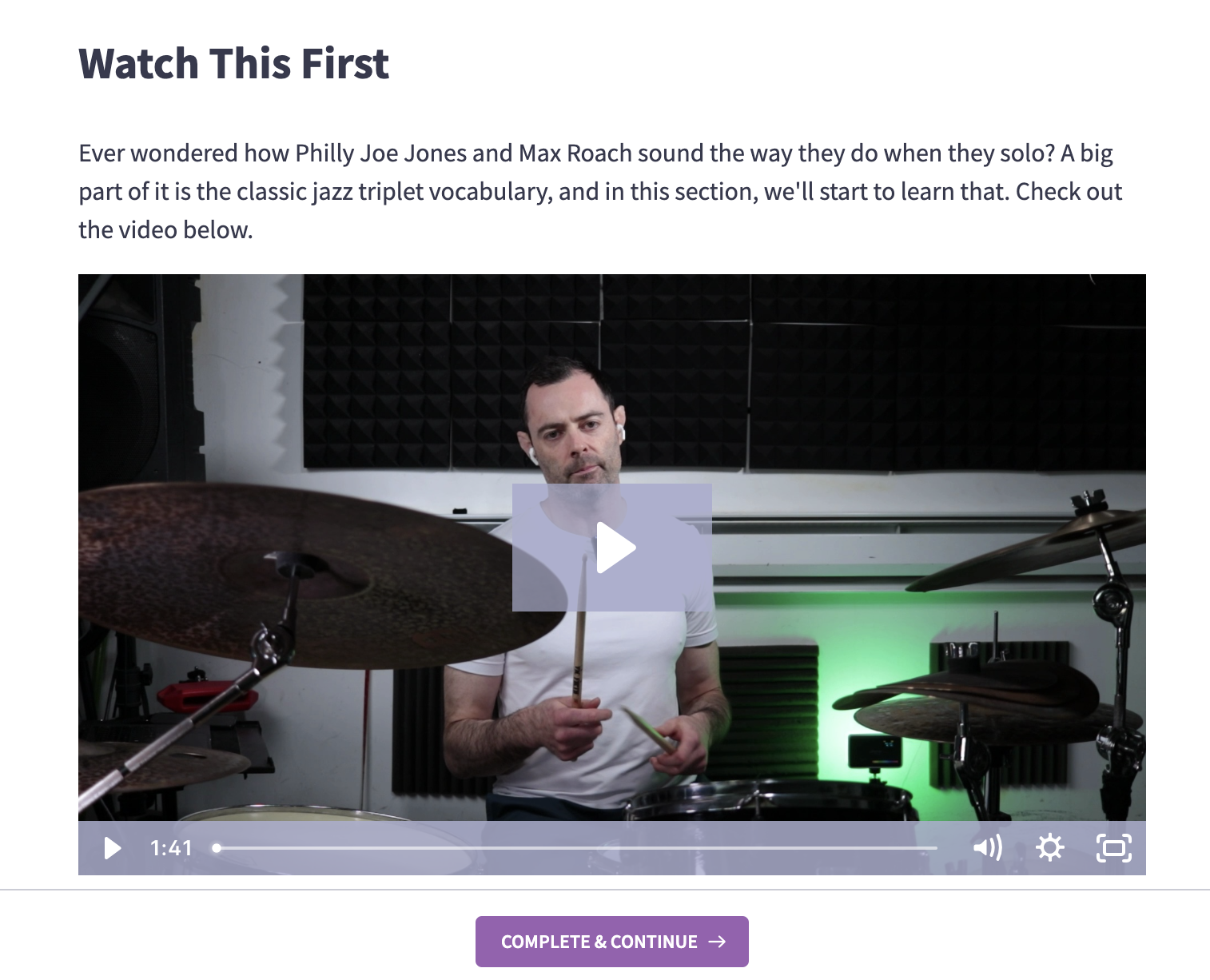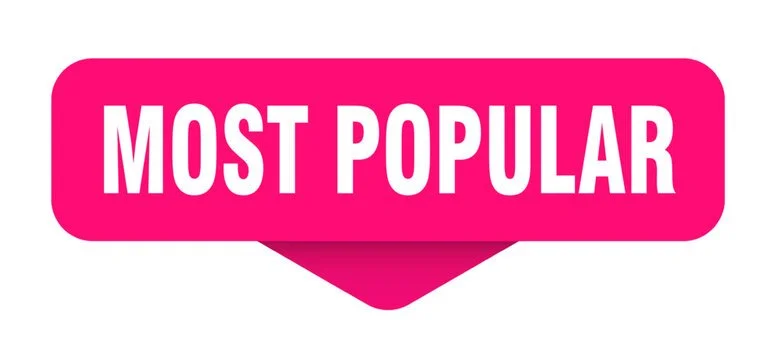get “jam session ready” at jazz drums
Get the only step-by-step “blueprint” to go from “I know a few jazz beats and coordination exercises out of books or online courses” to sounding good in ACTUAL PLAYING SITUATIONS, all in just 5 easy-to-follow modules.
There's a ton of material on playing jazz swing beats and jazz solos on drums. so how come you don’t feel “jam session ready"?
You’ve studied out of the books.
You’ve done some of the online courses. Maybe even some from famous jazz drummers.
But if you had to sit in on a jam session in front of a room full of people, could you?
If you know deep-down that the answer is “no”, this course is for you.
Greg Hutchinson embodies a blend of traditional and modern
So how come there’s such a big gulf between “play jazz stuff in the practice room”, and “sound good in real life”?
The reason is it's not just coordination. And it's not just comping vocabulary.
The truth is modern jazz drummers play the drums as a single instrument, phrasing things idiomatically in a way that just sounds "right", but which you can't put your finger on.
But playing lines from Syncopation - a great book I have no issue with by the way - with your left hand while you swing the ride cymbal is not getting you there.
Neither is practicing rudiments or rudimental solos - both of which I should emphasize are great, and important in their own way - getting you to play jazz solos that sound like Philly Joe Jones or Max Roach off the top of your head.
the “instruction gap” - why all those books haven’t prepared you for the “real” jazz
The reason is simple. Gen-1 instruction was meant to build up your coordination, so that you could execute all the hypothetical things you want to do in a jazz song on drums...
...then something something, and you'd just be playing jazz.
That something something usually involved a lot of hours of listening to jazz recordings - which, I must emphasize, is GREAT advice I'm not impugning...
...something something transcription...
...then, magically, you'd be able to play.
Well, luckily instruction methods have evolved. Today we can supply the missing pieces. And I made you a course to do it.
The Jazz Course
The objective of the jazz course is very simple. To take somebody who has or hasn't studied any jazz drums, but who has decent hands and decent coordination...
...and give them the tools to play stuff like this, off the top of their heads.
[hopefully arrive at a solo trading or something, and leave some space for it]
And when I say stuff lke this, I'm not even showing off. This is not a Nate Showing Off video. This is nate demoing the actual material from module 5.
How do we do it?
With a lot of the 8020 tools you might know and love. Or, if you don't, welcome!
We give you the fundamentals, then we give you exercises and challenges that will start you improvising with them, but with constraints.
a very little bit of the methodology of the jazz course
We give you the fundamentals, then we give you exercises and challenges that will start you improvising with them, but with constraints.
Constraints like "switch between these 2 or 3 licks".
Or "follow these specific instructions".Within the constraints, the licks you play are high-polish - it's the stuff you've practiced.
But instead of just sending you on your way, We supply the framework to work your way up, little by little, to actually improvising with them.That’s how you’ll go from feeling like a “tourist” in jazz drums - somebody who’s “aping” a language they don’t understand, to feeling like you own it. Like you’re speaking like a local.
(formally introducing) The jazz course
The first and only step-by-step course that hands you the tools to play authentic, personal jazz beats and solos, and the framework to feel ownership of the idiom and start using your own voice.
The Jazz Course takes all the lessons I’ve learned from my many years of playing and teaching jazz drums, and lays them out in an -easy-to-follow framework that walks you, step-by-step, to feeling and sounding like a “real jazz drummer”.
how we’ll do it
Step one: the swung 8th.
The first major building block of the Jazz Course is to ingrain the feeling of the swung 8th note deeply. With this in your toolkit, almost anything you. play will swing. Without it, you’ll be “chasing” the feel without ever fully capturing it.
Step 2: the touch.
From a solid foundation in swung 8th notes, we’ll focus on the next differentiator between “tourist” jazz beats and solos and “local” ones - the touch.
That means the touch on any individual drum or cymbal - for instance the ride cymbal beat - but also the relative volume of things. How loud should the bass drum be? What’s the ideal sound for the hi hat.
We’ll aim to give you a good muscle-memory of what playing good sounding jazz feels like.
Then...
Step 3: improvising with our ideas.
It's all well and good to memorize some exercises.
But in the real world we have to play beats off the top of our heads, and even vary them for different parts of the song. Not to mention taking the occasional fill without it throwing everything off. Not to mention trading.
That’s why the jazz course aims to give you a deep foundation in the tradition - from the ideas of originators like Warren “Baby” Dodds to bebop legends like “Philly” Joe Jones and Max Roach - but also, and importantly, to teach you to improvise with those ideas as soon as you get them under your hands. That way you arrive at the end not with a compendium of “written down” jazz solos, but with functional-fluency in being able to play them off the top of your head.
my promise with the jazz course
ALL of this is in the service of one thing: giving you a foundation in the traditional language, plus the tools to improvise with it, and make it your own.
And that's my promise with this course. If you complete the course material, you will be well-on-your-way to feeling like you “own” your jazz drumming. Like you’re a local; not a “tourist”.
Check out a real student’s results
Here we have the “before” and “after” videos of one of the first students to use the methods in this course.
inside the jazz course
The Jazz Course has over 97 separate videos, organized into 5 modules that grab you by the hand and take you step-by-step through the key insights and exercises to fine-tune your groove instincts.
It sequences the learning so that you're only working on what you can handle at the time, then builds little-by-little on the skills you acquire throughout.
how the course is organized
Detailed Explanations - For every skill or concept we introduce, there's a video talking you through it...
...then exercise pages with videos of me demonstrating the exercises, and transcriptions you can either view on the page - which I recommend - or download to your device or to print.Chapter Reviews - At the end of every module is a practice summary, which displays all the exercises and transcriptions in one place, and even offers suggestions for places you might want to record yourself to check your progress.
Learn on-Demand - And this course is self-paced, and on-demand, which means you can choose your own pace through the material.
Check out a sample video from the course
This video is from module 4, and explains a concept I call the “jazz beat algorithm”
table of contents - here’s everything the course covers
Module 1 - Fundamentals
Intro - Watch This First - Watch this before doing any exercises
Intro to Timekeeping - a basic orientation in how I approach using the metronome on triplets
Intro to “Nasheet Beats” - Nasheet Waits, with his love for New Orleans drumming and Warren "Baby" Dodds, was one of the biggest influences on my playing in my '20s.
Nasheet Prerequisites - Feet
Nasheet Exercises - Basic
Kick Feathering Intro - Now we'll dive into one of the most traditional elements of jazz drumming, but with two twists.
Kick Feathering Beats
Kick Feathering Algo - now we start to give you the operating system to derive your own “kick feathering beats”
Module 1 Practice Summary - This covers all the exercises and transcriptions in one convenient place
Module 2 - Mastering the Basics of Swing Beats and Jazz Solos
Intro to Module 2 - A concise summary of the how and why of everything to come
Intro to Nasheet Switching - Now we get into the first improvisation element using the source material from the Nasheet exercises in module 1
Nasheet Switching - Level One
Nasheet Switching - Level 2
Intro to Flam Series - The flam series extends on some of the "basic" vocabulary that will give you a correct "feeling" when we start to improvise more
Flam Series 1 - Basic
Flam Series 2 - Drags
Flam Series 3 - Ride
Kick Feathering Algo Part 2 - Triplets - Now we get into the second level of the kick feathering algorithm - the addition of triplets
Intro to Jazz Beats - As the video explains, jazz beats are the "instantiation" of the algorithm we'll learn in the subsequent modules
Module 2 Jazz Beats
Module 2 Practice Summary - This covers all the exercises and transcriptions in one convenient place
Module 3 - Advanced Swing and Solo Concepts
Intro to Module 3
3 Over The Barline Exercises
Flam Switching Exercises - Now we use the switching method to introduce a bit of improvisation to our flam exercises
Intro to Swung 8ths as Improv Vocabulary - Swung 8ths are the backbone of jazz improvisation. This video explains how we'll use them to build a solid foundation to your solo vocabulary
8th Offbeat Exercises - In this section, we move onto the next place to put the metronome - swung 8th offbeats
Swung 8th Switching Series
Intro to Triplets as Improv Vocabulary - Ever wondered how Philly Joe Jones and Max Roach sound the way they do when they solo? A big part of it is the classic jazz triplet vocabulary, and in this section, we'll start to learn that
Triplet Exercises Level 1
Triplet Exercises Level 2
5 Over The Barline
Jazz Beat Algorithm Part 1 - giving you the “operating system” for the jazz beats in module 1
Module 3 Practice Summary
Module 4 - Putting it All Together - Part 1
Intro to Module 4
Swing Algo Parts 2 and 3
Intro to Triplet Switching - Now it's time for one of the more challenging parts of the course. The triplet switching
Triplet Switching Exercises - Phase one
Triplet Switching Exercises - Phase 2
Intro to Advanced Swung 8th Switching - Now that we've got a good handle on basic swung 8th vocabulary, and even triplets, it's time to put in place one of the last pieces of the puzzle before we start improvising "real" jazz vocabulary
Advanced Swung 8th Switching Exercises
Module 4 Practice Summary
Module 5 - Putting it All Together - Part 2
Intro to Module 5
Intro to Triplet Integration - Now we come to the "money" chapter when it comes to authentic improvisation - integrating the triplet vocabulary with the swung 8ths
Triplet Integration Exercises - Phase One
Swung Beat Algorithm Part 4
Triplet Integration Exercises - Phase 2
Swung Beat Algorithm Part 5
Intro to Trading and Basic Trading - The final skill we want you to absorb before we "send you back into the world" is trading, that classic jazz staple. As this video explains, we'll divide it into two installments
Intro to Advanced Trading and Advanced Trading
Module 5 Practice Summary
What’s the investment?
Since last year, 3 enrollments worth of drummers have invested over $2000 to join programs like my group coaching, which is structured to be 12 weeks long, and includes personal coaching from me. And that’s a great choice for a drummer who wants personalized attention. But I wanted to build something accessible to way more drummers.
I wanted the Jazz Course to be so affordable it’s a no-brainer.
That’s why I made a self-directed course you can do at your own pace, so I’m able to offer it for a very low price:
The Jazz Course is just $197 for lifetime access.
But this is not just your average “here are a bunch of exercises; good luck” course, where I leave you to your own devices.
Just one of the many intro videos in the Jazz Course
Instead, I wanted the course to feel like a “virtual concierge” - like I’m taking you by the hand and walking you through the material.
That’s why the Jazz Course has a whole extra layer of intros and explainers.
For every single concept, I made a video telling why it’s important, how to practice it, and how it fits in the overall framework of the course.
So you can enroll with confidence that I’ve made it super easy to follow, and very hard to get lost. In fact, I’ll guarantee it.
my guarantee
I’m pretty sure this is the best course I’ve ever done.
That’s why I’m happy to guarantee it for 90 days.
Which means you can try the groove course risk free.
If it’s not the best self-directed resource for improving your pocket you’ve ever tried, just write us an email at nate@8020drummer.com, and we’ll refund you, no-questions asked.
ready to see what the jazz course can do for you?
This course is for you if…
You’re tired of feeling like a “tourist” when you play jazz - like you’re just imitating a language you don’t really understand.
You’re tired of working through all the exercises you’re “supposed to do”, and still feeling you’re miles away from being able to improvise your own ideas in this language.
You’re ready for a step-by-step system that takes you by the hand and shows you exactly to do - with no wasted time.
imagine yourself in this course
Over 97 separate videos, organized into 5 modules that grab you by the hand and take you step-by-step through the key insights and exercises to fine-tune your groove instincts.
Sequenced learning, so that you're only working on what you can handle at the time, then builds little-by-little on the skills you acquire throughout.
Detailed Explanations - For every skill or concept we introduce, there's a video talking you through it...
...then exercise pages with videos of me demonstrating the exercises, and transcriptions you can either view on the page - which I recommend - or download to your device or to print.
Chapter Reviews - At the end of every module is a practice summary, which displays all the exercises and transcriptions in one place, and even offers suggestions for places you might want to record yourself to check your progress.
Learn on-Demand - And this course is self-paced, and on-demand, which means you can choose your own pace through the material.
If you’re ready to arm yourself with new tools, and start feeling confident every time you sit down to play, I invite you to join now, risk-free.
limited time bonus
Join while this message is live on the website, and get a personalized “reaction video” from ME - something that’s usually reserved for my coaching students - included as your free gift.
Just join the course below, then you’ll receive an email with a Google Form and further instructions. Just upload your video to the form, and within one week, you’ll have a personalized critique and reaction from Yours Truly. I’ll help you hear your playing “from an outside perspective”, and point out details that will help you get the most from this course.
To claim your free bonus gift, just join while this message is still live.
Bonus = Still Available
Frequently asked questions
Is this the same as the jazz portion of the Coaching Course?
No, this is brand new. It shares some elements with the Coaching Course, but there’s only one exercise in common, out of over 97 video lessons.
Is this another premium coaching program that costs thousands?
No. This is an affordable, self-directed course.
You can get it for $197, or 2 monthly payments of $103, for lifetime access.
People have been asking for another self-directed course, and one on jazz specifically, for the past year, so I'm proud this is finally ready for showtime.
What do you mean by "jam session ready"?
You know what I mean if you've studied jazz out of books, then tried to go to a jam session.
There's another level of fluency you need. It feels like the good drummers have way more reps than you, but you're not sure at what.
Plus the vocabulary is a little different. Real jazz drummers don't sound like they're playing Jim Chapin - no offense to that excellent and foundational book.
The Jazz Course helps in 2 ways: first by giving you way more "specific reps" at idiomatic swing and solo vocabulary, so you'll feel way more ready when you sit in or play with a band.
Second by giving you - I'm sorry - more authentic vocabulary, so you're repping stuff that will translate to real playing situations.
What if I’m not sure?
You can try it risk-free.
If it’s not the best self-directed jazz course you’ve ever tried, you have 90 days to get your money back, no-questions-asked.
What’s the bonus?
We don’t really do “open/closed” anymore with our self-directed courses, because why would we stop people who want to learn stuff, since the courses are automated.
But we do want to do something special for people who join during a promotion, because that lets us plan our lives, because we know who’s “in” and who’s “out”.
That’s why we offer the “Nate feedback” bonus.
Usually, the only way to get my direct feedback on your playing is to join a coaching program for between $2200 and $6200.
The value of feedback cannot be overstated. Many students are making fundamental mistakes they don’t even realize - sorry - that are robbing them of getting the most value out of the material and costing them time.
That’s why, when you join the jazz course during this limited-time promotion, you’ll get my review of up to 10 minutes of your videos (which takes me more like a half hour to prepare and record), included as your free gift.
ready to get “jam session ready” at jazz drums in 5 easy modules?
Join risk-free by clicking below.













